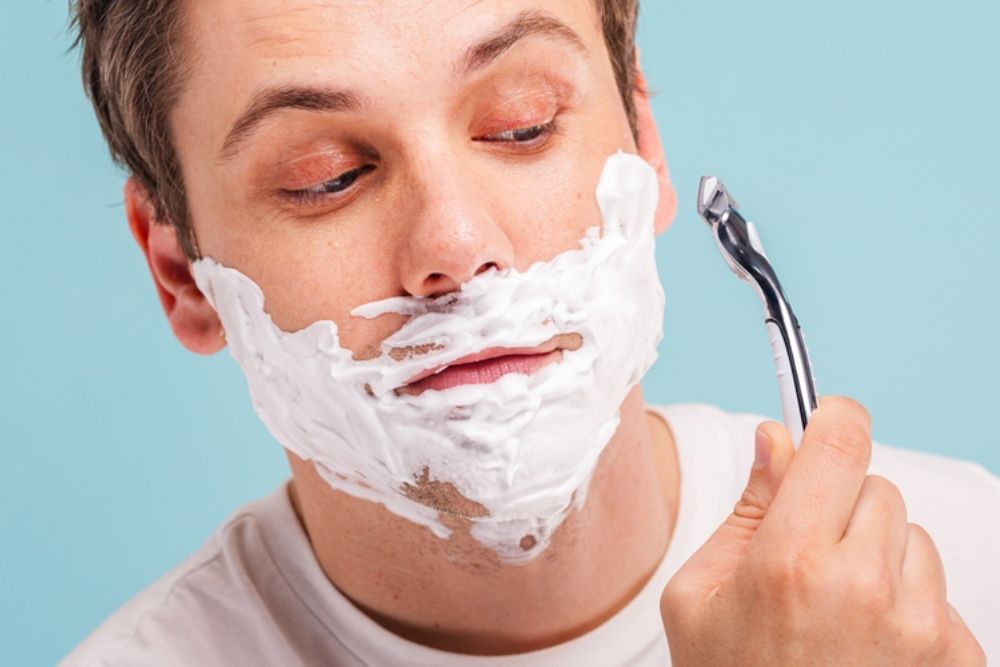For those with sensitive skin, the act of shaving can be fraught with potential discomfort—razor burn, itching, and redness. Yet, having the right shaving cream can make all the difference in ensuring a smooth, irritation-free shave. With countless shaving products on the market, it may feel daunting to find one that both protects your skin and improves your shaving experience. This guide explores what to look for in a shaving cream if you have sensitive skin, covering ingredient considerations, texture, and application tips so you can keep your skin calm while achieving a close, comfortable shave.
1. Why Sensitive Skin Requires Special Shaving Cream
Why It Matters
Those with sensitive skin often experience more intense reactions when the skin is disturbed—especially during shaving, which involves dragging sharp blades across the face or legs. A standard shaving cream may suffice for people with normal or oily skin, but individuals prone to redness or discomfort need products that minimize friction, reduce inflammation, and avoid triggers like harsh chemicals or fragrances.
Key Functions of a Good Cream
- Cushion and Lubrication: A quality formula creates a protective layer between the blade and your skin, reducing micro-cuts and razor burn.
- Moisturizing: Hydrating ingredients help soften hairs and skin, so the razor glides more smoothly.
- Soothing Agents: Certain botanicals and gentle compounds calm irritation.
- Low Irritants: Avoiding certain ingredients (like alcohol or strong fragrances) that can exacerbate sensitivity or dryness.
Takeaway
If you experience recurring irritation post-shave, switching to a cream specifically formulated for sensitive skin can be a game-changer, delivering both comfort and a cleaner shave.
2. Understanding Key Ingredients
Why It Matters
Ingredient composition largely determines whether a shaving cream is gentle or potentially irritating. For sensitive skin, seeking mild, nourishing, and anti-inflammatory components while avoiding known irritants is paramount.
Beneficial Ingredients
- Aloe Vera: Natural, soothing properties to calm redness and inflammation.
- Chamomile or Oat Extract: Gentle botanicals recognized for calming skin; helps alleviate minor irritation.
- Glycerin: A humectant that helps draw moisture to the skin, preserving its hydration barrier.
- Natural Oils (e.g., Jojoba, Coconut, Sweet Almond): Provide lubrication and moisture, although some oils might not suit everyone—test if you’re extremely reactive.
- Shea Butter or Cocoa Butter: Rich but can help lock in moisture; best in small amounts or in well-formulated creams to avoid heavy residue.
Potential Irritants
- Alcohol: Can dry out or sting sensitive skin, promoting razor burn.
- Strong Synthetic Fragrances: May provoke allergic reactions or redness.
- Harsh Surfactants: These can overly strip oils from the skin, leading to dryness and sensitivity.
- Menthol or Eucalyptus: While they provide a “cooling” sensation, some find these irritating if their skin is already reactive.
Takeaway
Study labels carefully. Look for formulas labeled “fragrance-free,” “hypoallergenic,” or “dermatologist-tested.” The best approach for truly sensitive skin is to focus on mild, moisturizing ingredients and minimal chemical complexity.
3. Choosing the Right Texture and Format
Why It Matters
Shaving products come in various forms—traditional creams, gels, foams, or soaps. Each offers a distinct texture and ease-of-use, which can influence comfort during shaving.
Common Formats
- Traditional Cream (Tube or Tub)
- Pros: Typically rich and dense, providing a thick cushioning layer. Often more concentrated, so a small amount can go a long way.
- Cons: Requires a bit of effort to lather (possibly using a shaving brush), but many find the result extremely protective for sensitive skin.
- Gel
- Pros: Clear or semi-translucent, easier to see where you’re shaving. Often water-based, which might be gentle on the skin.
- Cons: Some gels contain strong fragrances or alcohol. Must check labels for sensitivity-friendly variants.
- Aerosol Foam
- Pros: Quick and convenient—just spray and apply.
- Cons: Some foams can be drying due to propellants or higher chemical content. They also might not offer as dense a cushion as cream.
- Shaving Soap
- Pros: Traditional option that, when used with a brush, can create a thick lather. Natural formulations often exist for sensitive skin.
- Cons: Requires a bit more skill and time to build a proper lather, plus you need a brush and bowl setup.
Takeaway
If you’re new to shaving or have very tender skin, a denser cream or well-formulated gel can provide ample lubrication and comfort. Those who want minimal fuss might choose a sensitive-skin foam, but read the label for potential irritants.

4. Matching Shaving Technique to Your Skin’s Needs
Why It Matters
Even the best shaving cream for sensitive skin won’t help if your technique is overly rough or your razor is dull. Pairing proper technique with your shaving product ensures minimal irritation.
Technique Tips
- Prep the Skin: Use lukewarm water or a warm towel to soften whiskers or hair before applying cream. This opens pores and eases the glide.
- Use Light Pressure: Let the razor do the cutting; pressing too hard invites razor burn. Multiple gentle passes are better than one forceful swipe.
- Shave with the Grain: Go in the direction of hair growth initially to reduce tugging. If needed, do a second pass cross- or against-the-grain carefully.
- Rinse Often: Keeping the blade clean avoids buildup that can drag over skin.
- Post-Shave Care: Rinse with cool water, then apply a soothing, alcohol-free aftershave or moisturizer to calm redness and close pores.
Takeaway
Slowing down, using gentle strokes, and complementing your shaving cream with correct blade usage can greatly reduce irritation—especially crucial if you have sensitive skin.
5. Brand Reputation and Product Testing
Why It Matters
Real-world user experiences can inform you about how gentle a product truly is. Sensitive-skin-labeled items aren’t always created equal, so reading reviews or testing samples can help you avoid guesswork.
Research Checklist
- Read Ingredient Lists: Familiarize yourself with common irritants or beneficial elements for your sensitivity.
- User Testimonials: Check feedback from individuals with similar skin concerns—especially about post-shave redness or tightness.
- Samples/Travel Sizes: Some companies offer smaller tubes to test tolerance before committing to a large container.
- Dermatologist-Recommended Lines: Some brands specialized in sensitive or medical skincare can be safer bets if your skin reacts easily.
Takeaway
While brand name alone doesn’t guarantee success, well-established producers with lines specifically for sensitive skin can be a safer option. Experiment carefully—sometimes an under-the-radar brand might also prove surprisingly gentle.
6. Budget vs. Quality
Why It Matters
From drugstore products to high-end boutique creams, prices can vary dramatically. If you shave daily, the cost can add up, so balancing budget with performance is key.
Budget Tips
- Mid-Range Creams: Many drugstore brands offer “sensitive” lines that might work well. Check reviews for dryness or questionable ingredients.
- Bulk or Subscription: If you find a product that suits you, buying multipacks or subscribing to a service can lower per-unit cost.
- Niche or Premium Brands: These may contain refined or natural ingredients, minimal chemicals, and strong brand credentials—but can cost more. If your skin is extremely reactive, it might be worth the splurge.
Takeaway
Don’t assume the most expensive product is always best. Start by sampling affordable sensitive-skin formulas; if they’re inadequate, consider investing in pricier, dermatologist-endorsed brands.
7. Putting It All Together
Why It Matters
With so many factors—ingredient lists, product textures, brand claims—narrowing down a single shaving cream might seem tough. But focusing on a few key criteria (lack of irritants, sufficient lubrication, actual user feedback) will help you land on a product that meets your needs.
Action Plan
- Identify Known Irritants: Make a mental list of triggers (alcohol, strong fragrances, certain essential oils) and scan labels thoroughly.
- Try a Small Test Patch: Apply on a small area (e.g., side of the jaw). If no reaction occurs after a day or two, proceed with a full shave.
- Pair with Proper Prep: A mild facial cleanser or pre-shave oil can also minimize friction.
- Observe Results: After a few uses, assess if your skin looks calmer and less red. If dryness or bumps persist, consider adjusting your technique or trying a different cream.
Takeaway
Combining knowledge of your skin’s sensitivities with a carefully chosen product and gentler shaving habits can drastically reduce irritation, letting you enjoy the ritual of a smooth shave.
Choosing the right shaving cream for sensitive skin goes beyond just reading “gentle” or “sensitive” on the label—it involves recognizing which ingredients help soothe and protect and which might aggravate your skin. From mild, fragrance-free formulations to those infused with aloe or chamomile, a high-quality shaving cream can help cushion the blade and retain moisture, preventing the nicks and redness that make shaving an ordeal for sensitive types.
But remember, the product is only part of the equation. Proper technique—using light pressure, shaving with the grain, and employing a suitable razor—plays a big role in reducing discomfort. If you’re uncertain, experiment with small samples, consult reviews from fellow sensitive-skin sufferers, and be patient while trying different routines. With the right approach, you’ll transform shaving from a painful necessity into a comfortable, confidence-boosting part of your daily or weekly routine. Enjoy smoother, happier skin—minus the irritation!





